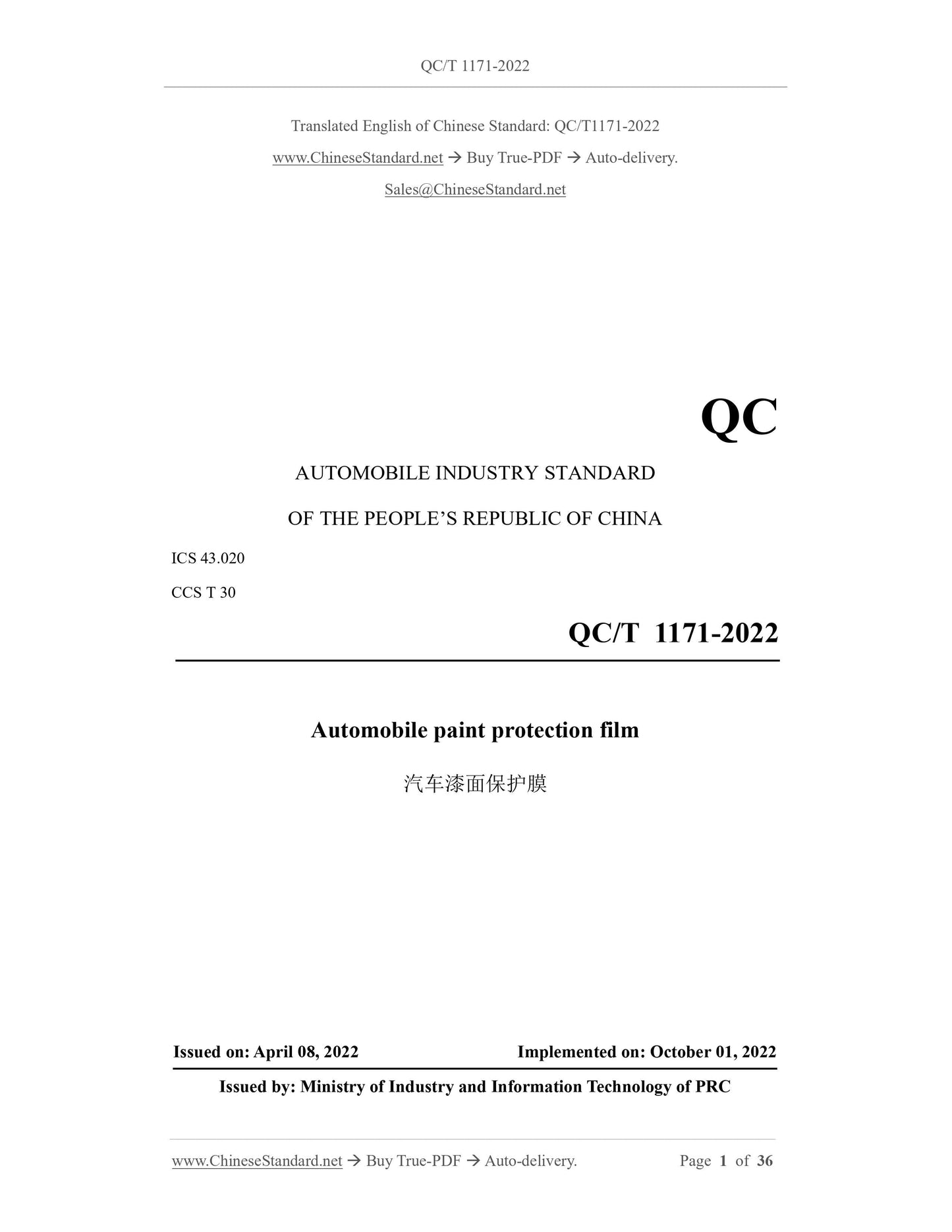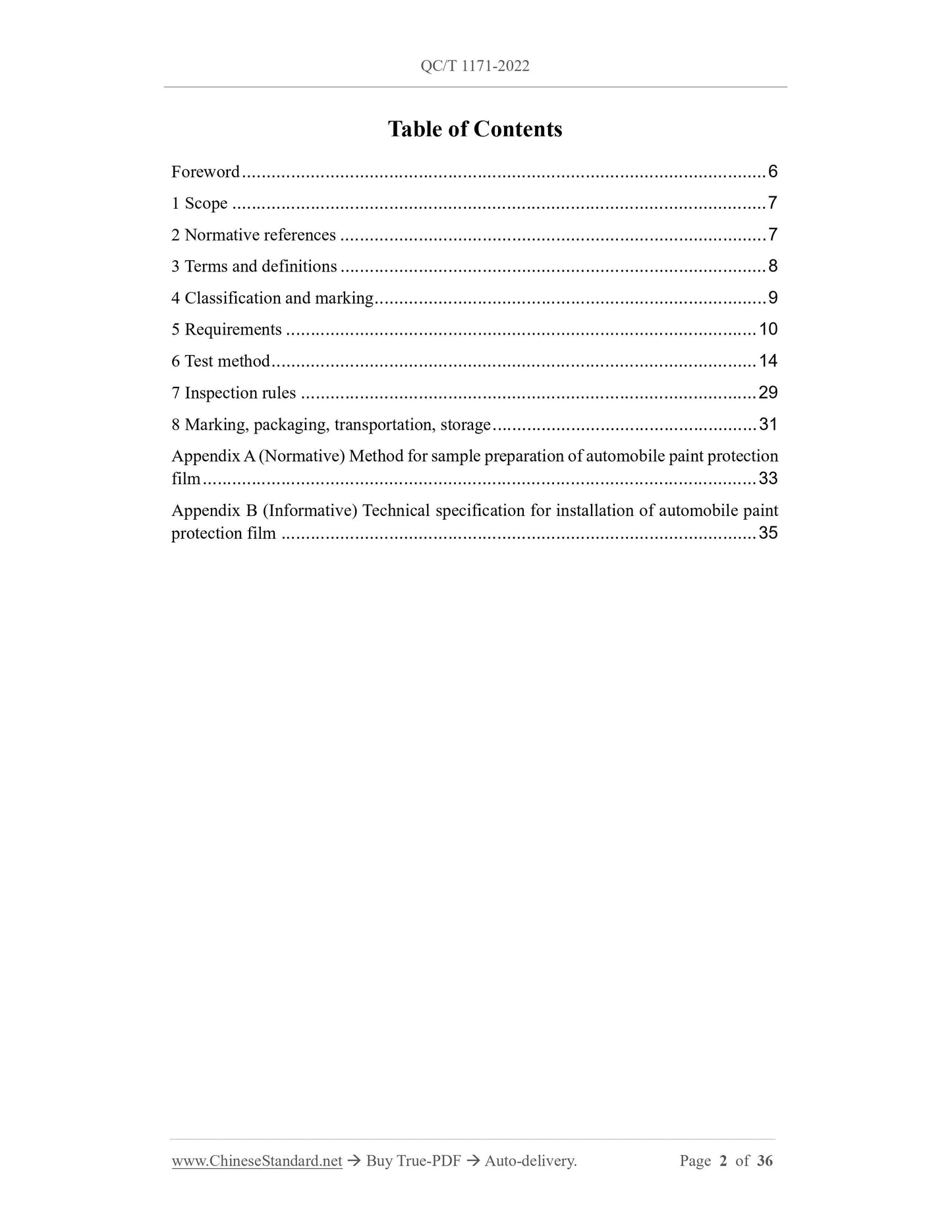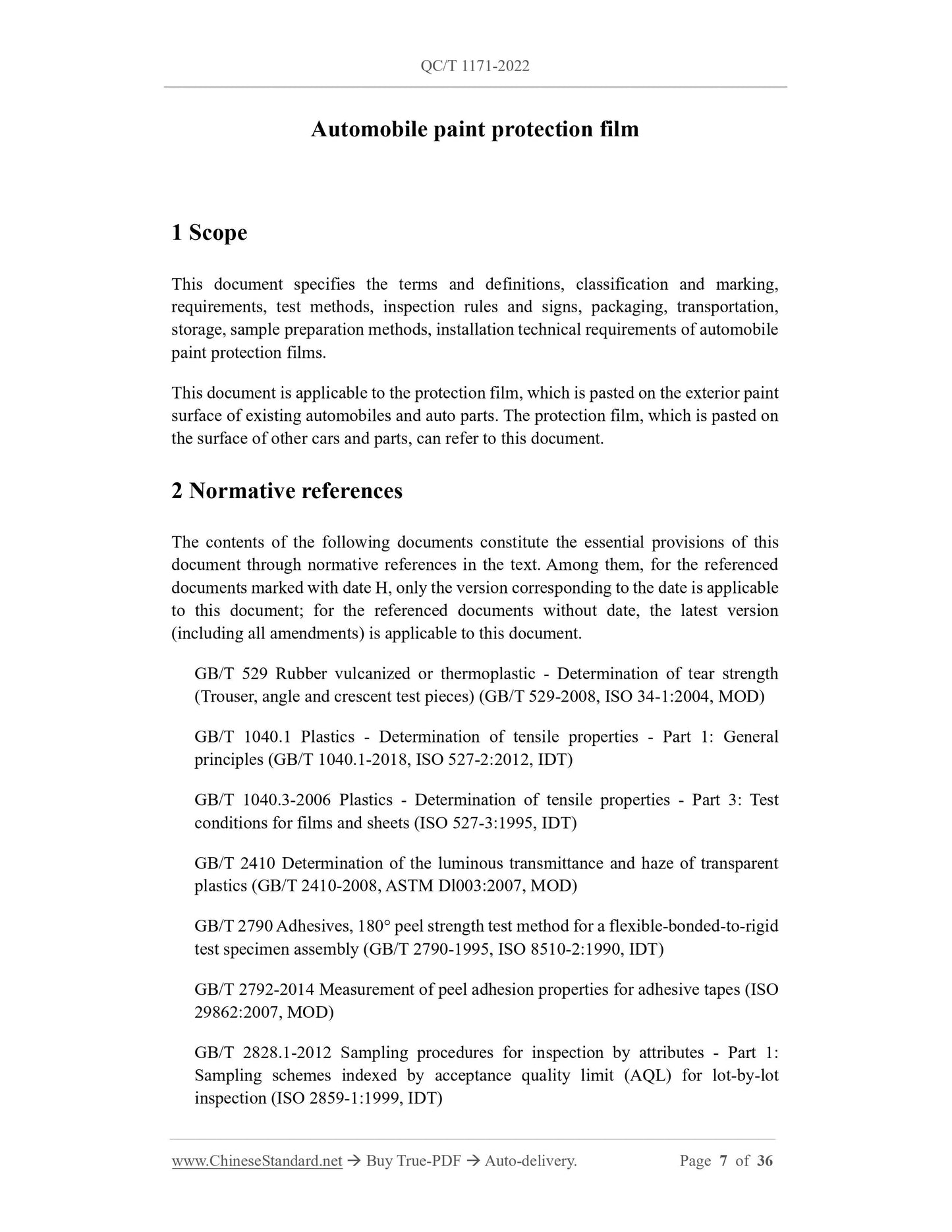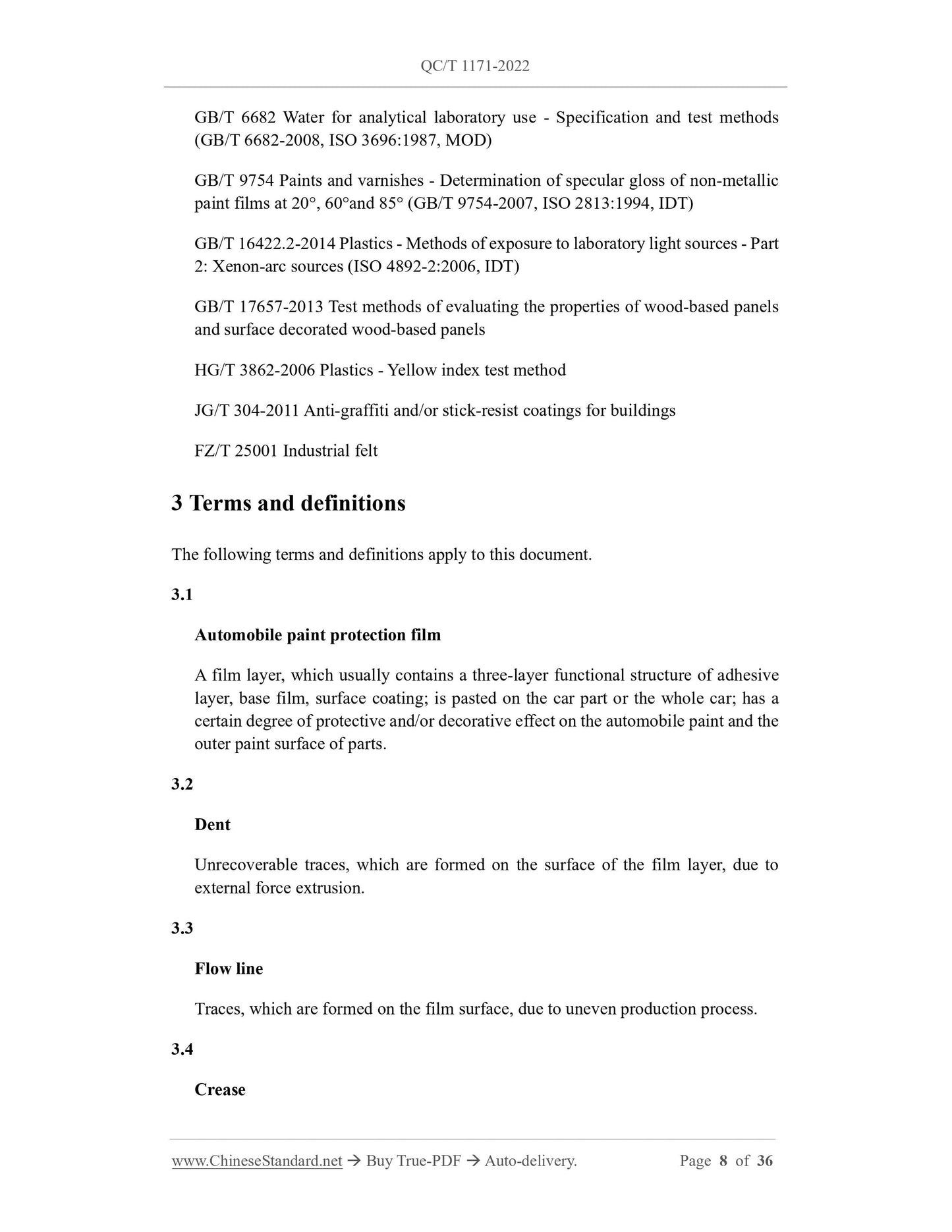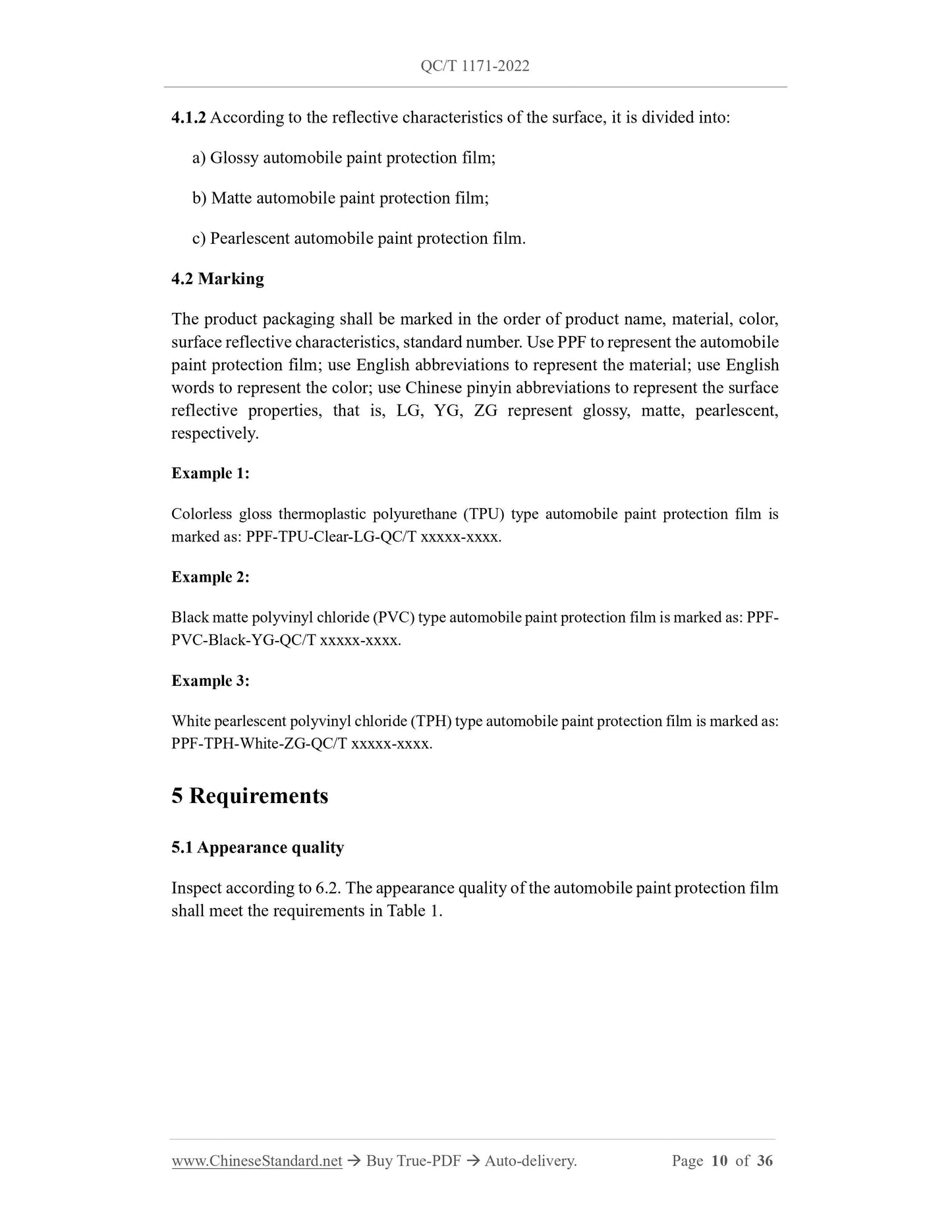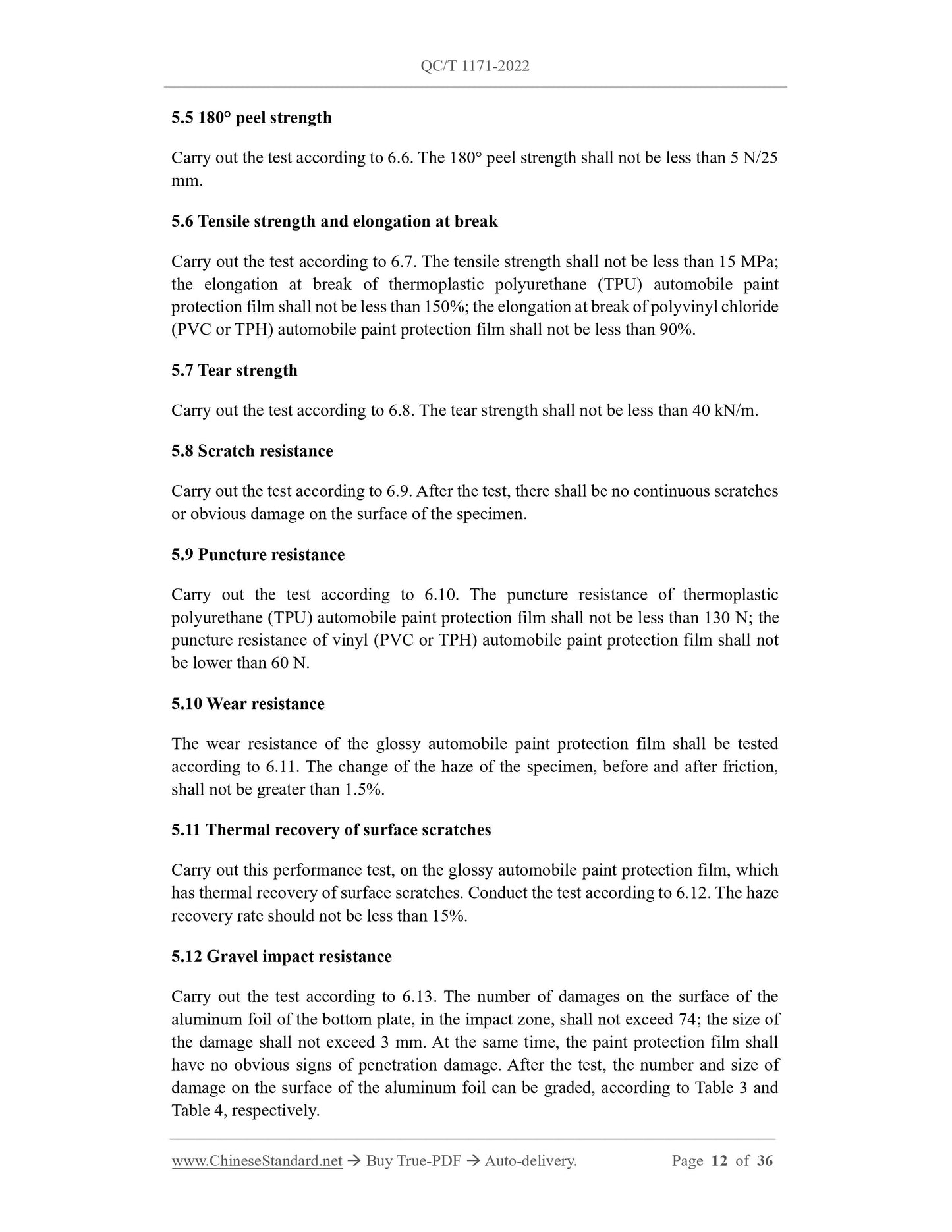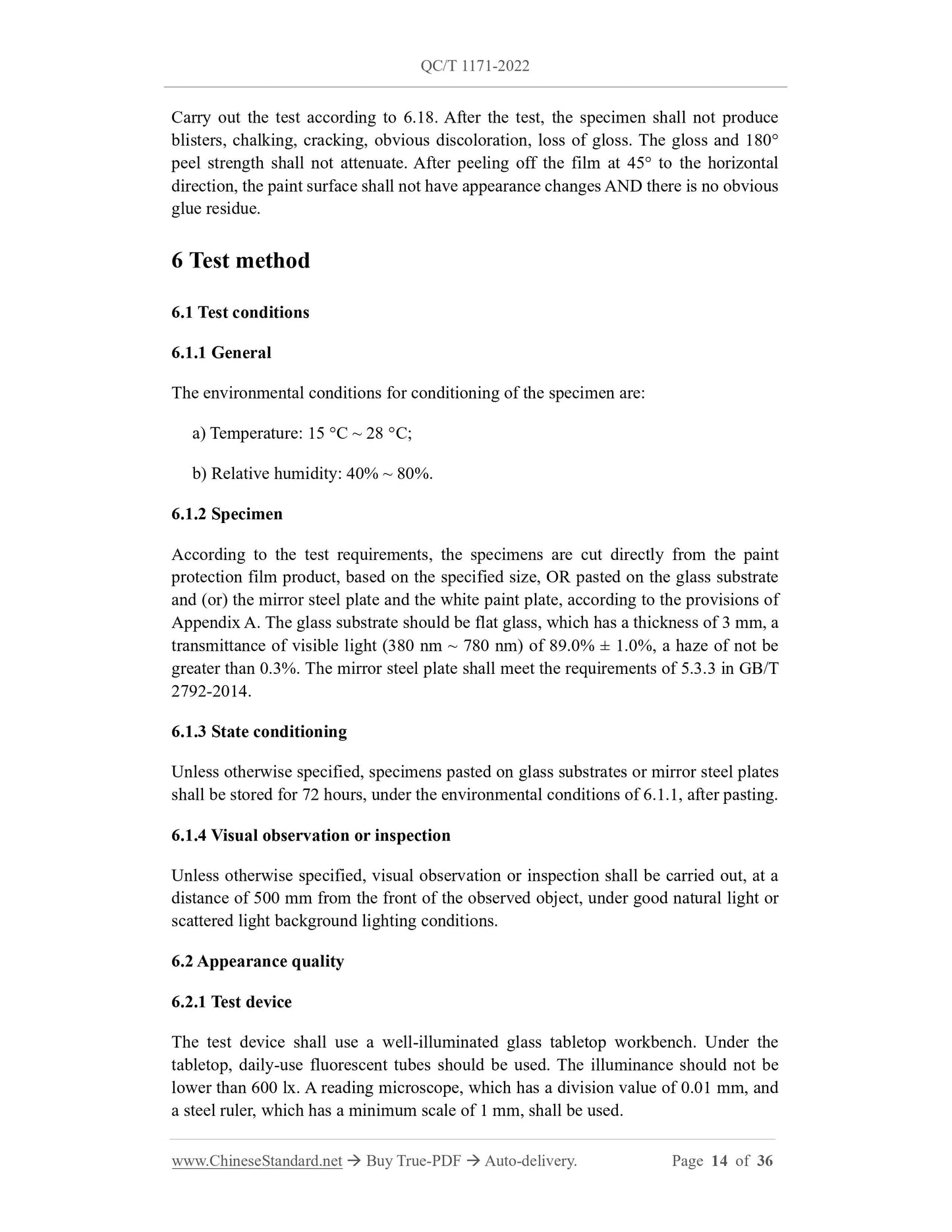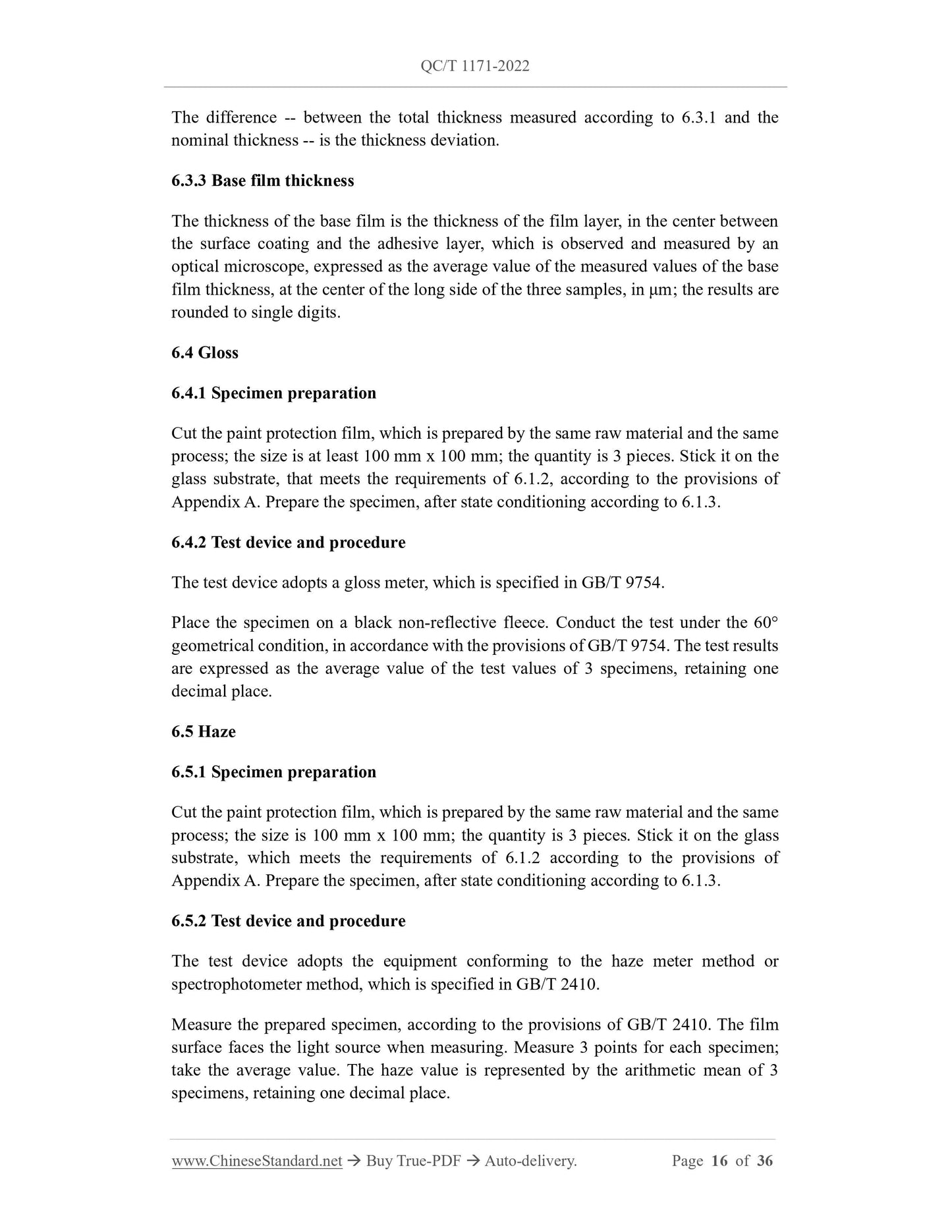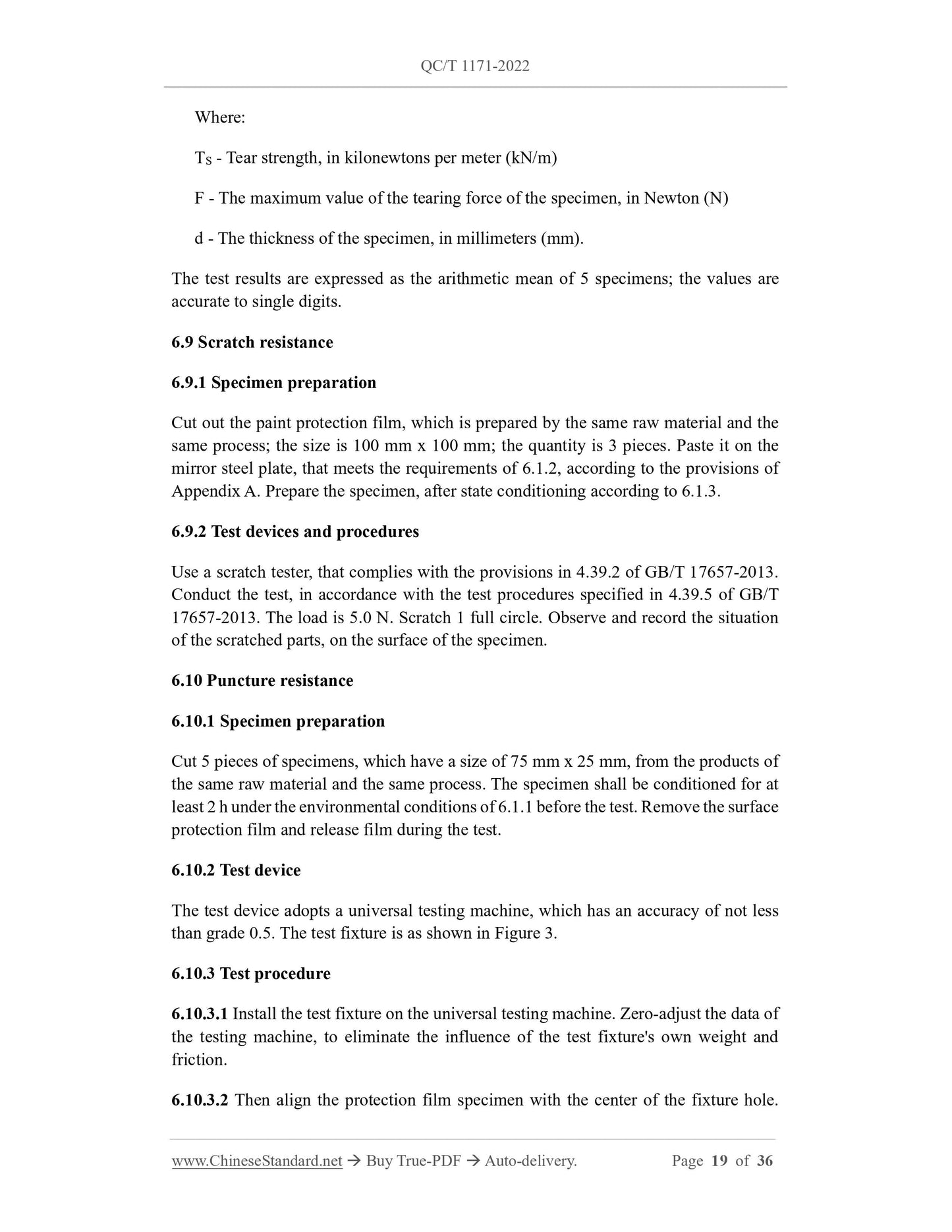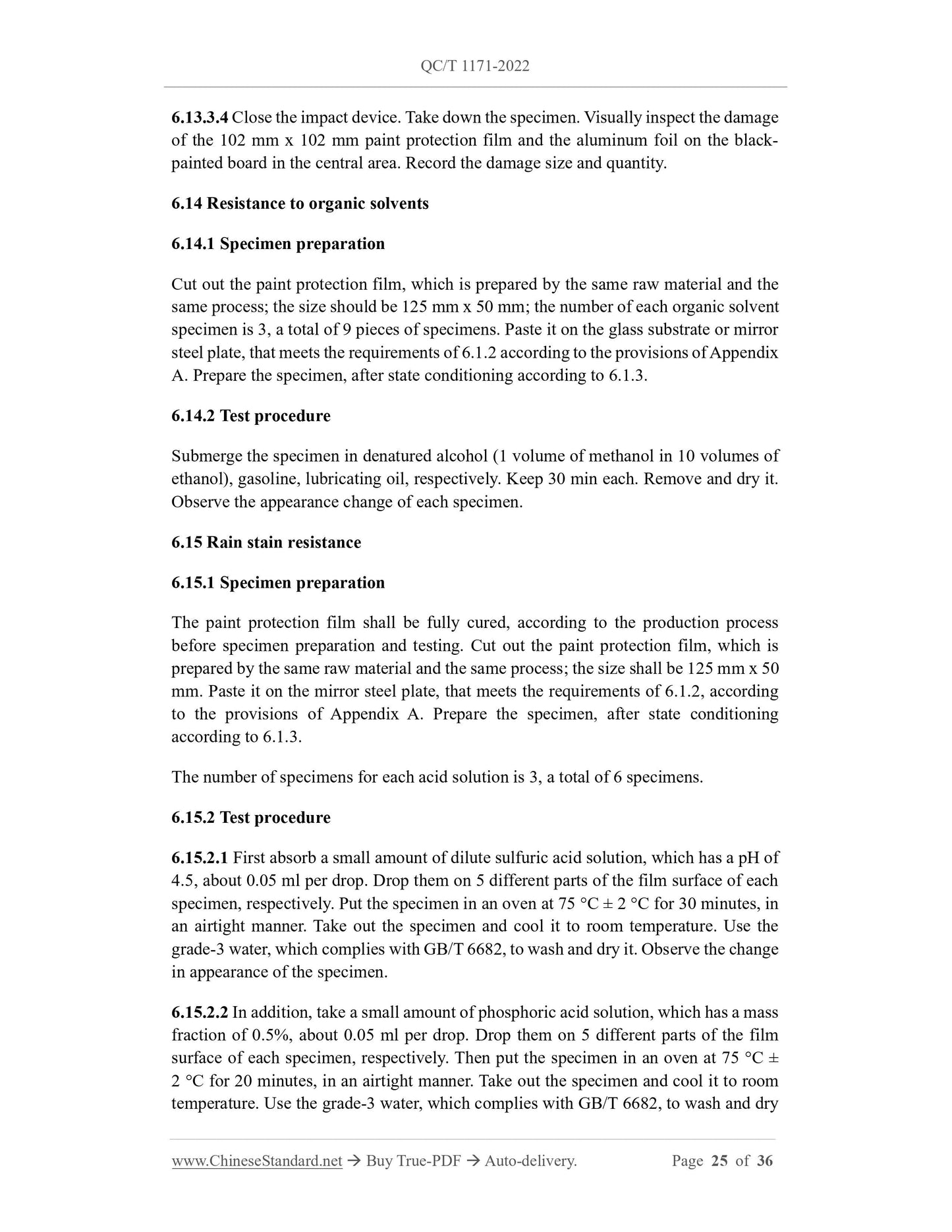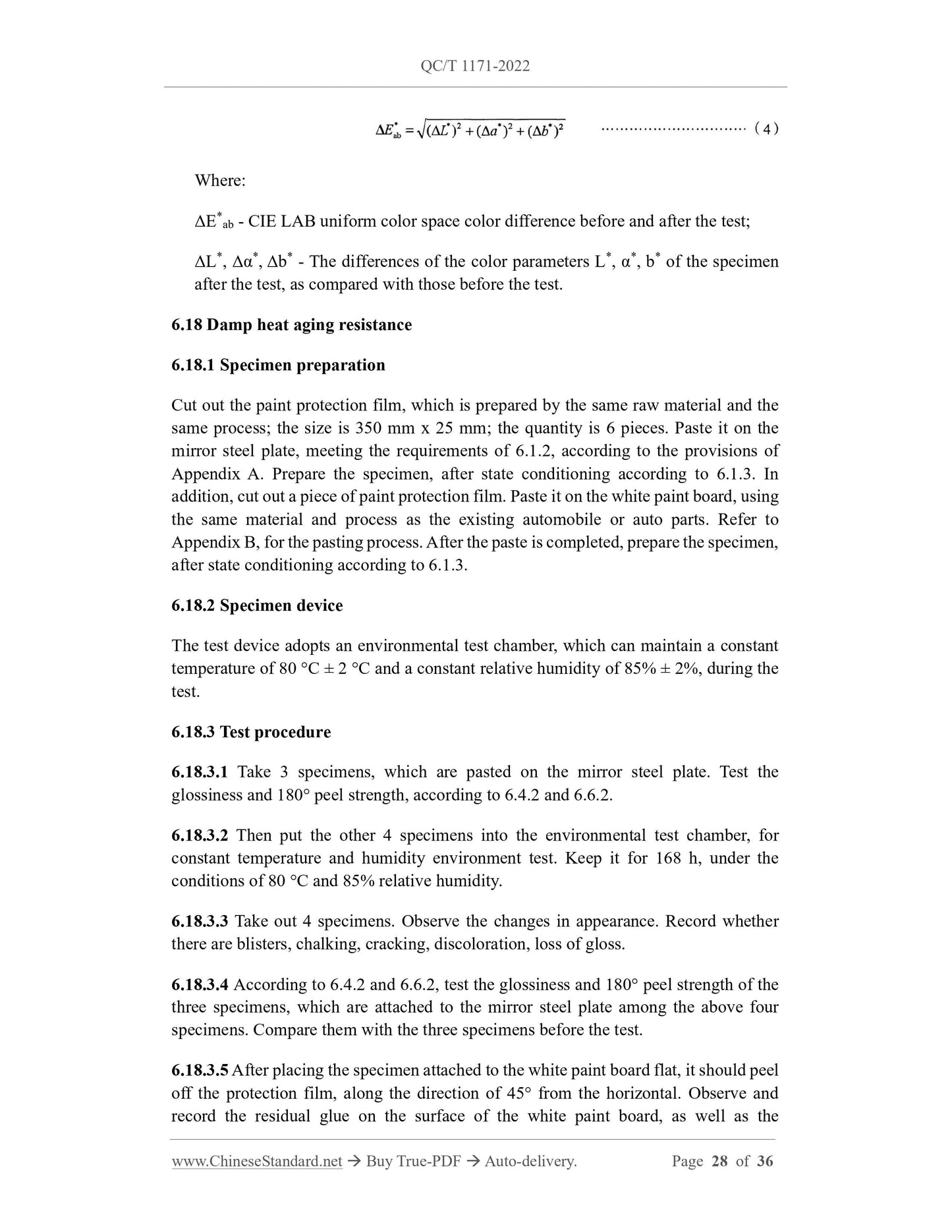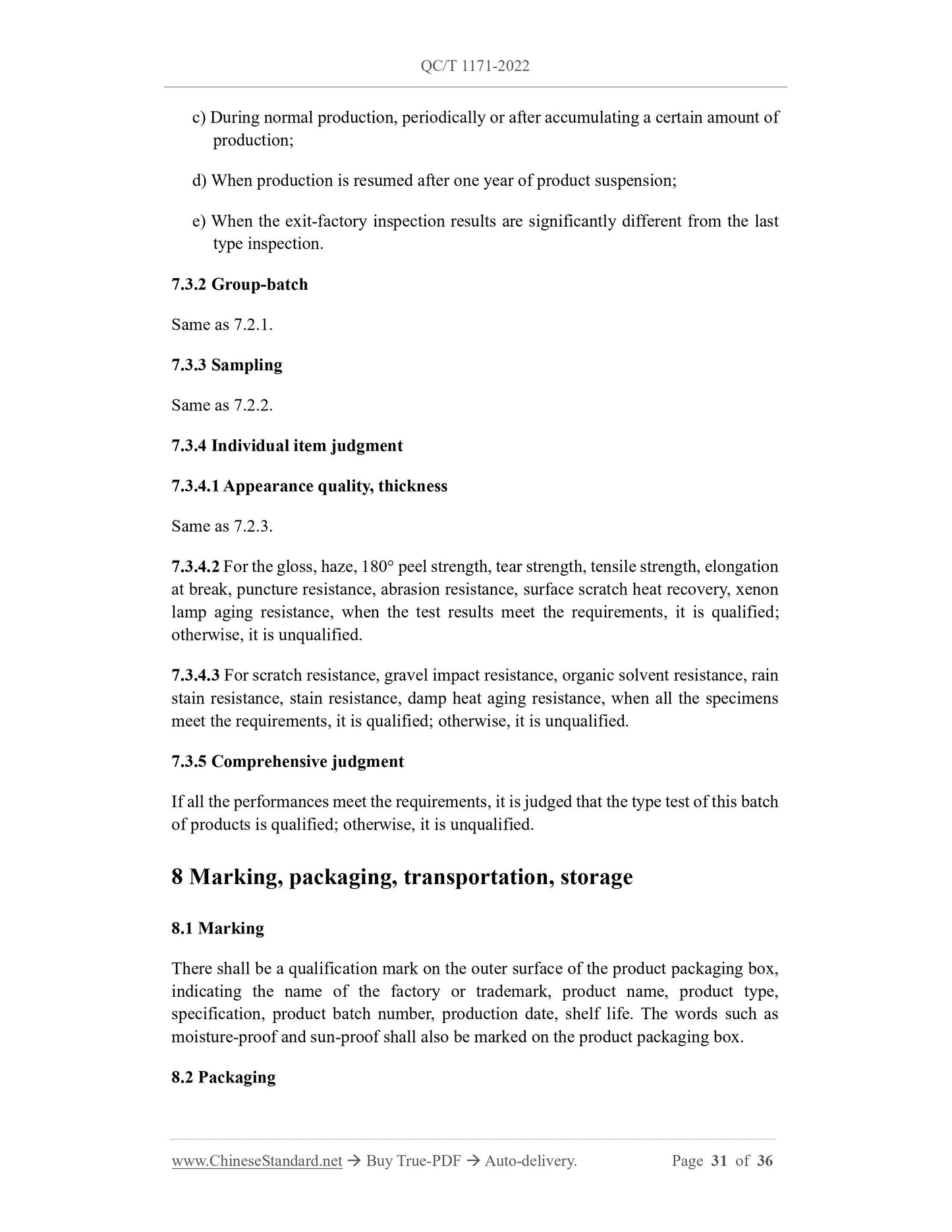1
/
of
12
PayPal, credit cards. Download editable-PDF & invoice in 1 second!
QC/T 1171-2022 English PDF (QCT1171-2022)
QC/T 1171-2022 English PDF (QCT1171-2022)
Regular price
$380.00 USD
Regular price
Sale price
$380.00 USD
Unit price
/
per
Shipping calculated at checkout.
Couldn't load pickup availability
Delivery: 3 seconds. Download true-PDF + Invoice.
Get QUOTATION in 1-minute: Click QC/T 1171-2022
Historical versions: QC/T 1171-2022
Preview True-PDF (Reload/Scroll if blank)
QC/T 1171-2022: Automotive paint protection film
QC/T 1171-2022
QC
AUTOMOBILE INDUSTRY STANDARD
OF THE PEOPLE’S REPUBLIC OF CHINA
ICS 43.020
CCS T 30
Automobile paint protection film
ISSUED ON: APRIL 08, 2022
IMPLEMENTED ON: OCTOBER 01, 2022
Issued by: Ministry of Industry and Information Technology of PRC
Table of Contents
Foreword ... 6
1 Scope ... 7
2 Normative references ... 7
3 Terms and definitions ... 8
4 Classification and marking ... 9
5 Requirements ... 10
6 Test method ... 14
7 Inspection rules ... 29
8 Marking, packaging, transportation, storage ... 31
Appendix A (Normative) Method for sample preparation of automobile paint protection
film ... 33
Appendix B (Informative) Technical specification for installation of automobile paint
protection film ... 35
Automobile paint protection film
1 Scope
This document specifies the terms and definitions, classification and marking,
requirements, test methods, inspection rules and signs, packaging, transportation,
storage, sample preparation methods, installation technical requirements of automobile
paint protection films.
This document is applicable to the protection film, which is pasted on the exterior paint
surface of existing automobiles and auto parts. The protection film, which is pasted on
the surface of other cars and parts, can refer to this document.
2 Normative references
The contents of the following documents constitute the essential provisions of this
document through normative references in the text. Among them, for the referenced
documents marked with date H, only the version corresponding to the date is applicable
to this document; for the referenced documents without date, the latest version
(including all amendments) is applicable to this document.
GB/T 529 Rubber vulcanized or thermoplastic - Determination of tear strength
(Trouser, angle and crescent test pieces) (GB/T 529-2008, ISO 34-1:2004, MOD)
GB/T 1040.1 Plastics - Determination of tensile properties - Part 1: General
principles (GB/T 1040.1-2018, ISO 527-2:2012, IDT)
GB/T 1040.3-2006 Plastics - Determination of tensile properties - Part 3: Test
conditions for films and sheets (ISO 527-3:1995, IDT)
GB/T 2410 Determination of the luminous transmittance and haze of transparent
plastics (GB/T 2410-2008, ASTM Dl003:2007, MOD)
GB/T 2790 Adhesives, 180° peel strength test method for a flexible-bonded-to-rigid
test specimen assembly (GB/T 2790-1995, ISO 8510-2:1990, IDT)
GB/T 2792-2014 Measurement of peel adhesion properties for adhesive tapes (ISO
29862:2007, MOD)
GB/T 2828.1-2012 Sampling procedures for inspection by attributes - Part 1:
Sampling schemes indexed by acceptance quality limit (AQL) for lot-by-lot
inspection (ISO 2859-1:1999, IDT)
GB/T 6682 Water for analytical laboratory use - Specification and test methods
(GB/T 6682-2008, ISO 3696:1987, MOD)
GB/T 9754 Paints and varnishes - Determination of specular gloss of non-metallic
paint films at 20°, 60°and 85° (GB/T 9754-2007, ISO 2813:1994, IDT)
GB/T 16422.2-2014 Plastics - Methods of exposure to laboratory light sources - Part
2: Xenon-arc sources (ISO 4892-2:2006, IDT)
GB/T 17657-2013 Test methods of evaluating the properties of wood-based panels
and surface decorated wood-based panels
HG/T 3862-2006 Plastics - Yellow index test method
JG/T 304-2011 Anti-graffiti and/or stick-resist coatings for buildings
FZ/T 25001 Industrial felt
3 Terms and definitions
The following terms and definitions apply to this document.
3.1
Automobile paint protection film
A film layer, which usually contains a three-layer functional structure of adhesive
layer, base film, surface coating; is pasted on the car part or the whole car; has a
certain degree of protective and/or decorative effect on the automobile paint and the
outer paint surface of parts.
3.2
Dent
Unrecoverable traces, which are formed on the surface of the film layer, due to
external force extrusion.
3.3
Flow line
Traces, which are formed on the film surface, due to uneven production process.
3.4
Crease
4.1.2 According to the reflective characteristics of the surface, it is divided into:
a) Glossy automobile paint protection film;
b) Matte automobile paint protection film;
c) Pearlescent automobile paint protection film.
4.2 Marking
The product packaging shall be marked in the order of product name, material, color,
surface reflective characteristics, standard number. Use PPF to represent the automobile
paint protection film; use English abbreviations to represent the material; use English
words to represent the color; use Chinese pinyin abbreviations to represent the surface
reflective properties, that is, LG, YG, ZG represent glossy, matte, pearlescent,
respectively.
Example 1:
Colorless gloss thermoplastic polyurethane (TPU) type automobile paint protection film is
marked as: PPF-TPU-Clear-LG-QC/T xxxxx-xxxx.
Example 2:
Black matte polyvinyl chloride (PVC) type automobile paint protection film is marked as: PPF-
PVC-Black-YG-QC/T xxxxx-xxxx.
Example 3:
White pearlescent polyvinyl chloride (TPH) type automobile paint protection film is marked as:
PPF-TPH-White-ZG-QC/T xxxxx-xxxx.
5 Requirements
5.1 Appearance quality
Inspect according to 6.2. The appearance quality of the automobile paint protection film
shall meet the requirements in Table 1.
5.5 180° peel strength
Carry out the test according to 6.6. The 180° peel strength shall not be less than 5 N/25
mm.
5.6 Tensile strength and elongation at break
Carry out the test according to 6.7. The tensile strength shall not be less than 15 MPa;
the elongation at break of thermoplastic polyurethane (TPU) automobile paint
protection film shall not be less than 150%; the elongation at break of polyvinyl chloride
(PVC or TPH) automobile paint protection film shall not be less than 90%.
5.7 Tear strength
Carry out the test according to 6.8. The tear strength shall not be less than 40 kN/m.
5.8 Scratch resistance
Carry out the test according to 6.9. After the test, there shall be no continuous scratches
or obvious damage on the surface of the specimen.
5.9 Puncture resistance
Carry out the test according to 6.10. The puncture resistance of thermoplastic
polyurethane (TPU) automobile paint protection film shall not be less than 130 N; the
puncture resistance of vinyl (PVC or TPH) automobile paint protection film shall not
be lower than 60 N.
5.10 Wear resistance
The wear resistance of the glossy automobile paint protection film shall be tested
according to 6.11. The change of the haze of the specimen, before and after friction,
shall not be greater than 1.5%.
5.11 Thermal recovery of surface scratches
Carry out this performance test, on the glossy automobile paint protection film, which
has thermal recovery of surface scratches. Conduct the test according to 6.12. The haze
recovery rate should not be less than 15%.
5.12 Gravel impact resistance
Carry out the test according to 6.13. The number of damages on the surface of the
aluminum foil of the bottom plate, in the impact zone, shall not exceed 74; the size of
the damage shall not exceed 3 mm. At the same time, the paint protection film shall
have no obvious signs of penetration damage. After the test, the number and size of
damage on the surface of the aluminum foil can be graded, according to Table 3 and
Table 4, respectively.
Carry out the test according to 6.18. After the test, the specimen shal...
Get QUOTATION in 1-minute: Click QC/T 1171-2022
Historical versions: QC/T 1171-2022
Preview True-PDF (Reload/Scroll if blank)
QC/T 1171-2022: Automotive paint protection film
QC/T 1171-2022
QC
AUTOMOBILE INDUSTRY STANDARD
OF THE PEOPLE’S REPUBLIC OF CHINA
ICS 43.020
CCS T 30
Automobile paint protection film
ISSUED ON: APRIL 08, 2022
IMPLEMENTED ON: OCTOBER 01, 2022
Issued by: Ministry of Industry and Information Technology of PRC
Table of Contents
Foreword ... 6
1 Scope ... 7
2 Normative references ... 7
3 Terms and definitions ... 8
4 Classification and marking ... 9
5 Requirements ... 10
6 Test method ... 14
7 Inspection rules ... 29
8 Marking, packaging, transportation, storage ... 31
Appendix A (Normative) Method for sample preparation of automobile paint protection
film ... 33
Appendix B (Informative) Technical specification for installation of automobile paint
protection film ... 35
Automobile paint protection film
1 Scope
This document specifies the terms and definitions, classification and marking,
requirements, test methods, inspection rules and signs, packaging, transportation,
storage, sample preparation methods, installation technical requirements of automobile
paint protection films.
This document is applicable to the protection film, which is pasted on the exterior paint
surface of existing automobiles and auto parts. The protection film, which is pasted on
the surface of other cars and parts, can refer to this document.
2 Normative references
The contents of the following documents constitute the essential provisions of this
document through normative references in the text. Among them, for the referenced
documents marked with date H, only the version corresponding to the date is applicable
to this document; for the referenced documents without date, the latest version
(including all amendments) is applicable to this document.
GB/T 529 Rubber vulcanized or thermoplastic - Determination of tear strength
(Trouser, angle and crescent test pieces) (GB/T 529-2008, ISO 34-1:2004, MOD)
GB/T 1040.1 Plastics - Determination of tensile properties - Part 1: General
principles (GB/T 1040.1-2018, ISO 527-2:2012, IDT)
GB/T 1040.3-2006 Plastics - Determination of tensile properties - Part 3: Test
conditions for films and sheets (ISO 527-3:1995, IDT)
GB/T 2410 Determination of the luminous transmittance and haze of transparent
plastics (GB/T 2410-2008, ASTM Dl003:2007, MOD)
GB/T 2790 Adhesives, 180° peel strength test method for a flexible-bonded-to-rigid
test specimen assembly (GB/T 2790-1995, ISO 8510-2:1990, IDT)
GB/T 2792-2014 Measurement of peel adhesion properties for adhesive tapes (ISO
29862:2007, MOD)
GB/T 2828.1-2012 Sampling procedures for inspection by attributes - Part 1:
Sampling schemes indexed by acceptance quality limit (AQL) for lot-by-lot
inspection (ISO 2859-1:1999, IDT)
GB/T 6682 Water for analytical laboratory use - Specification and test methods
(GB/T 6682-2008, ISO 3696:1987, MOD)
GB/T 9754 Paints and varnishes - Determination of specular gloss of non-metallic
paint films at 20°, 60°and 85° (GB/T 9754-2007, ISO 2813:1994, IDT)
GB/T 16422.2-2014 Plastics - Methods of exposure to laboratory light sources - Part
2: Xenon-arc sources (ISO 4892-2:2006, IDT)
GB/T 17657-2013 Test methods of evaluating the properties of wood-based panels
and surface decorated wood-based panels
HG/T 3862-2006 Plastics - Yellow index test method
JG/T 304-2011 Anti-graffiti and/or stick-resist coatings for buildings
FZ/T 25001 Industrial felt
3 Terms and definitions
The following terms and definitions apply to this document.
3.1
Automobile paint protection film
A film layer, which usually contains a three-layer functional structure of adhesive
layer, base film, surface coating; is pasted on the car part or the whole car; has a
certain degree of protective and/or decorative effect on the automobile paint and the
outer paint surface of parts.
3.2
Dent
Unrecoverable traces, which are formed on the surface of the film layer, due to
external force extrusion.
3.3
Flow line
Traces, which are formed on the film surface, due to uneven production process.
3.4
Crease
4.1.2 According to the reflective characteristics of the surface, it is divided into:
a) Glossy automobile paint protection film;
b) Matte automobile paint protection film;
c) Pearlescent automobile paint protection film.
4.2 Marking
The product packaging shall be marked in the order of product name, material, color,
surface reflective characteristics, standard number. Use PPF to represent the automobile
paint protection film; use English abbreviations to represent the material; use English
words to represent the color; use Chinese pinyin abbreviations to represent the surface
reflective properties, that is, LG, YG, ZG represent glossy, matte, pearlescent,
respectively.
Example 1:
Colorless gloss thermoplastic polyurethane (TPU) type automobile paint protection film is
marked as: PPF-TPU-Clear-LG-QC/T xxxxx-xxxx.
Example 2:
Black matte polyvinyl chloride (PVC) type automobile paint protection film is marked as: PPF-
PVC-Black-YG-QC/T xxxxx-xxxx.
Example 3:
White pearlescent polyvinyl chloride (TPH) type automobile paint protection film is marked as:
PPF-TPH-White-ZG-QC/T xxxxx-xxxx.
5 Requirements
5.1 Appearance quality
Inspect according to 6.2. The appearance quality of the automobile paint protection film
shall meet the requirements in Table 1.
5.5 180° peel strength
Carry out the test according to 6.6. The 180° peel strength shall not be less than 5 N/25
mm.
5.6 Tensile strength and elongation at break
Carry out the test according to 6.7. The tensile strength shall not be less than 15 MPa;
the elongation at break of thermoplastic polyurethane (TPU) automobile paint
protection film shall not be less than 150%; the elongation at break of polyvinyl chloride
(PVC or TPH) automobile paint protection film shall not be less than 90%.
5.7 Tear strength
Carry out the test according to 6.8. The tear strength shall not be less than 40 kN/m.
5.8 Scratch resistance
Carry out the test according to 6.9. After the test, there shall be no continuous scratches
or obvious damage on the surface of the specimen.
5.9 Puncture resistance
Carry out the test according to 6.10. The puncture resistance of thermoplastic
polyurethane (TPU) automobile paint protection film shall not be less than 130 N; the
puncture resistance of vinyl (PVC or TPH) automobile paint protection film shall not
be lower than 60 N.
5.10 Wear resistance
The wear resistance of the glossy automobile paint protection film shall be tested
according to 6.11. The change of the haze of the specimen, before and after friction,
shall not be greater than 1.5%.
5.11 Thermal recovery of surface scratches
Carry out this performance test, on the glossy automobile paint protection film, which
has thermal recovery of surface scratches. Conduct the test according to 6.12. The haze
recovery rate should not be less than 15%.
5.12 Gravel impact resistance
Carry out the test according to 6.13. The number of damages on the surface of the
aluminum foil of the bottom plate, in the impact zone, shall not exceed 74; the size of
the damage shall not exceed 3 mm. At the same time, the paint protection film shall
have no obvious signs of penetration damage. After the test, the number and size of
damage on the surface of the aluminum foil can be graded, according to Table 3 and
Table 4, respectively.
Carry out the test according to 6.18. After the test, the specimen shal...
Share
